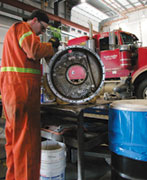...played out in the U.S. District Court in Peoria, Ill., where Caterpillar Inc. is trying to gain a home-court advantage in patent-infringement litigation related to its “ACERT” engine line.
Peoria-based Cat in December filed suit against Entec Engine Corp., Atlanta, asking the court for a declaratory judgment that Caterpillar’s ACERT technology was its own. Entec and its chairman, Clyde C. Bryant, allege otherwise.
According to court documents, Bryant and his intellectual property company approached Caterpillar in 1999 with a revolutionary new type of engine that used charged-air cooling during the compression stroke to reduce emissions. Most engine manufacturers favored feeding cooled exhaust gas into the combustion cylinder during the intake stroke. Bryant received a patent for his “cold-air induction engine” in 2001.
 |
| Wrenching. New engines increase training demands. (Photo by Tudor Hampton for ENR) |
Caterpillar declined to purchase a license from Entec and in 2003 unveiled what it called a “breakthrough” engine with “Advanced Combustion Emissions Reduction Technology,” or ACERT. Cat claimed the engines met EPA regulations while keeping fuel economy at the same level as its 2001 engines—and 3% to 5% better than the competition. It did not go into detail on how ACERT actually worked.
Despite the secrecy, the roll-out was generally well received by equipment owners. Cat engineers James Weber and Scott Leman received a key patent for ACERT in 2004, and later earned a top award from the Intellectual Property Owners Association.
Bryant’s firm accused Caterpillar of “trying to cover up” the fact that it was “putting cooled, highly compressed air into the cylinder during the compression stroke, rather than during the intake stroke as do all other engines.” Entec already was engaged in licensing talks with two foreign engine companies and two domestic ones. It again unsuccessfully offered Cat a licensing opportunity, and Bryant in 2004 challenged two of Cat’s patents, including the Weber and Leman patent, in administrative proceedings (ENR 11/01/04 p. 17). So far, U.S. patent examiners have ruled in Bryant’s favor, but they have not yet invalidated Cat’s patents.
Caterpillar and Entec entered into settlement talks late last year but were unable to reach an agreement. Entec’s lawyers decline to comment on the pending lawsuit, but Caterpillar Chairman James W. Owens says that he feels “very confident in the patent protection that we have on ACERT technology.” He adds, “We are going to contest these things to the end.”
The legal troubles have not stopped Cat from expanding its clean-diesel engine line to off-road vehicles and introducing a new line of truck transmissions, scheduled for production this year. The new powertrain business mirrors most manufacturers’ efforts to increase the efficiency of their engines.
Integrated components “work together, talk the same language, use the same electronics,” says Tom Wickenhauser, Cat’s transmission spokesman. Pamela L. Carter, president of Cummins’ filtration arm Fleetguard Inc., adds, “The key going forward will be materials. Fully integrating your electronic controls, the turbocharger, air handling, filtration and fuel systems are going to play a much greater role.”

Post a comment to this article
Report Abusive Comment